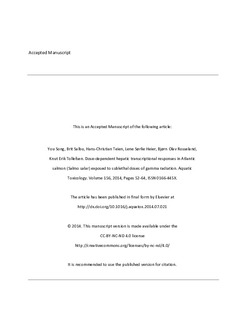| dc.description.abstract | Due to the production of free radicals, gamma radiation may pose a hazard to living organisms. The high-dose radiation effects have been extensively studied, whereas the ecotoxicity data on low-dose gamma radiation is still limited. The present study was therefore performed using Atlantic salmon (Salmo salar) to characterize effects of low-dose (15, 70 and 280 mGy) gamma radiation after short-term (48 h) exposure. Global transcriptional changes were studied using a combination of high-density oligonucleotide microarrays and quantitative real-time reverse transcription polymerase chain reaction (qPCR). Differentially expressed genes (DEGs; in this article the phrase gene expression is taken as a synonym of gene transcription, although it is acknowledged that gene expression can also be regulated, e.g., at protein stability and translational level) were determined and linked to their biological meanings predicted using both Gene Ontology (GO) and mammalian ortholog-based functional analyses. The plasma glucose level was also measured as a general stress biomarker at the organism level. Results from the microarray analysis revealed a dose-dependent pattern of global transcriptional responses, with 222, 495 and 909 DEGs regulated by 15, 70 and 280 mGy gamma radiation, respectively. Among these DEGs, only 34 were commonly regulated by all radiation doses, whereas the majority of differences were dose-specific. No GO functions were identified at low or medium doses, but repression of DEGs associated with GO functions such as DNA replication, cell cycle regulation and response to reactive oxygen species (ROS) were observed after 280 mGy gamma exposure. Ortholog-based toxicity pathway analysis further showed that 15 mGy radiation affected DEGs associated with cellular signaling and immune response; 70 mGy radiation affected cell cycle regulation and DNA damage repair, cellular energy production; and 280 mGy radiation affected pathways related to cell cycle regulation and DNA repair, mitochondrial dysfunction and immune functions. Twelve genes representative of key pathways found in this study were verified by qPCR. Potential common MoAs of low-dose gamma radiation may include induction of oxidative stress, DNA damage and disturbance of oxidative phosphorylation (OXPHOS). Although common MoAs were proposed, a number of DEGs and pathways were still found to be dose-specific, potentially indicating multiple mechanisms of action (MOAs) of low-dose gamma radiation in fish. In addition, plasma glucose displayed an apparent increase with increasing radiation doses, although the results were not significantly different from the control. These findings suggested that sublethal doses of gamma radiation may cause dose-dependent transcriptional changes in the liver of Atlantic salmon after short-term exposure. The current study predicted multiple MoA for gamma radiation and may aid future impact assessment of environmental radioactivity in fish. | nb_NO |

